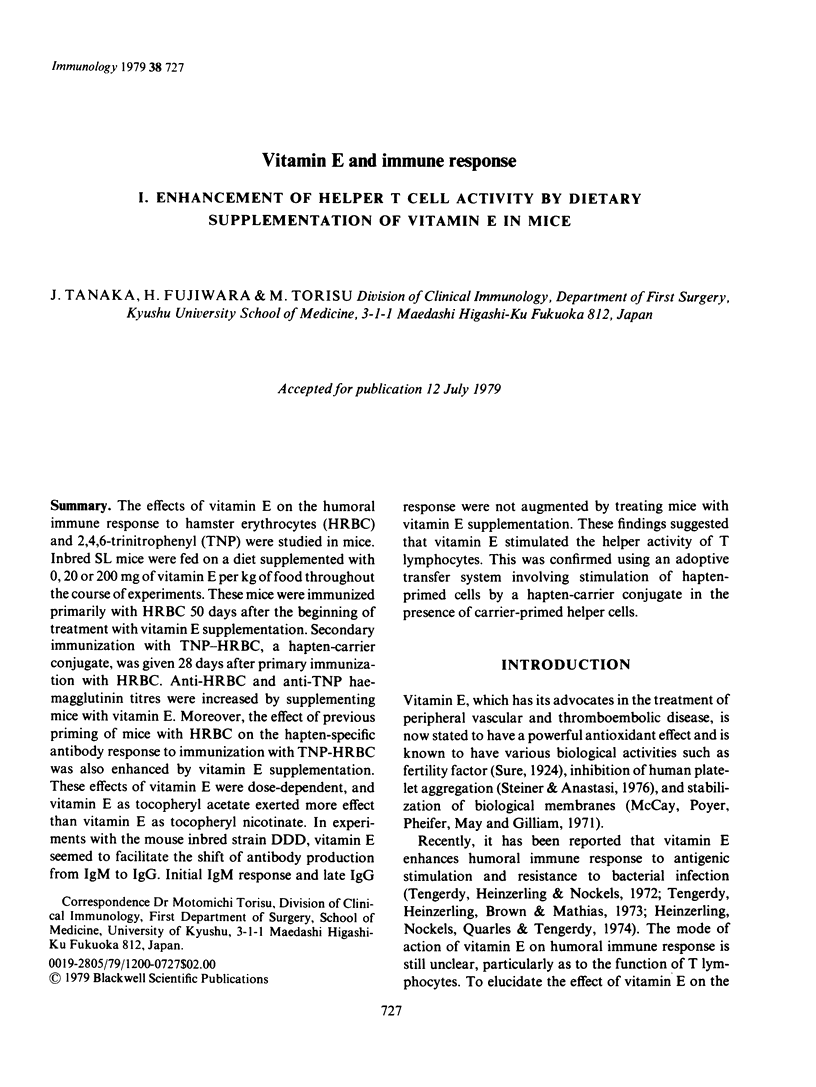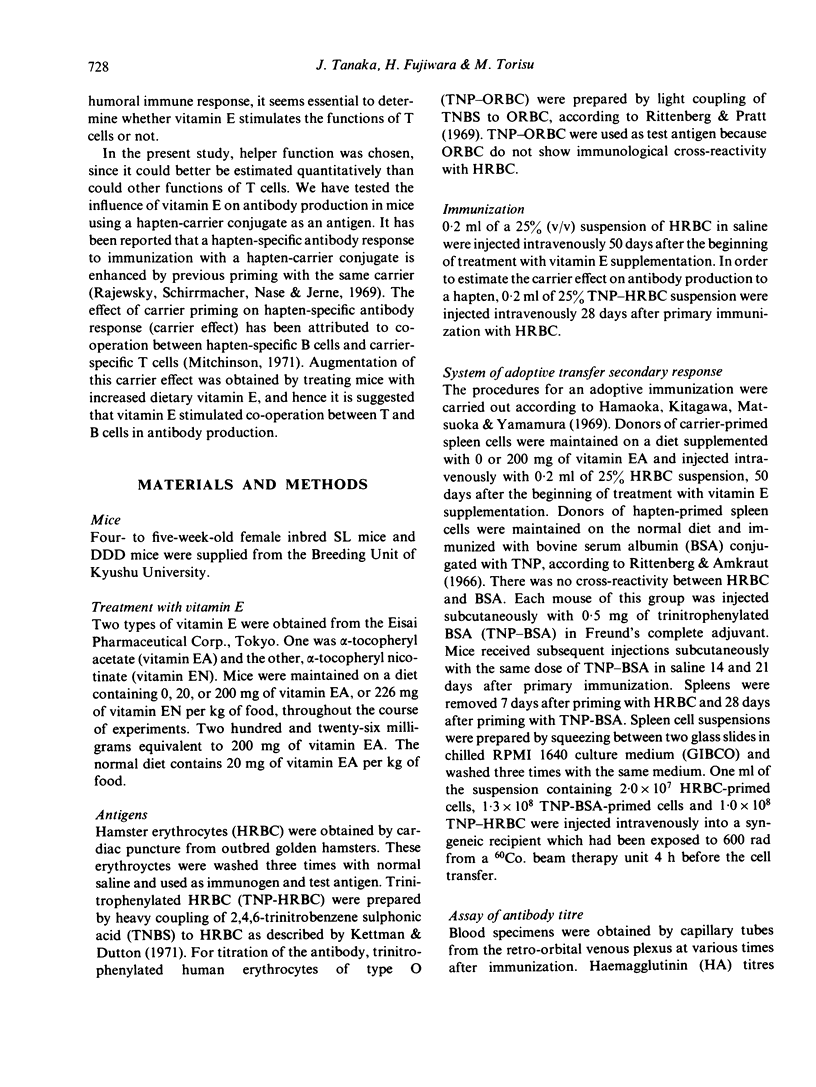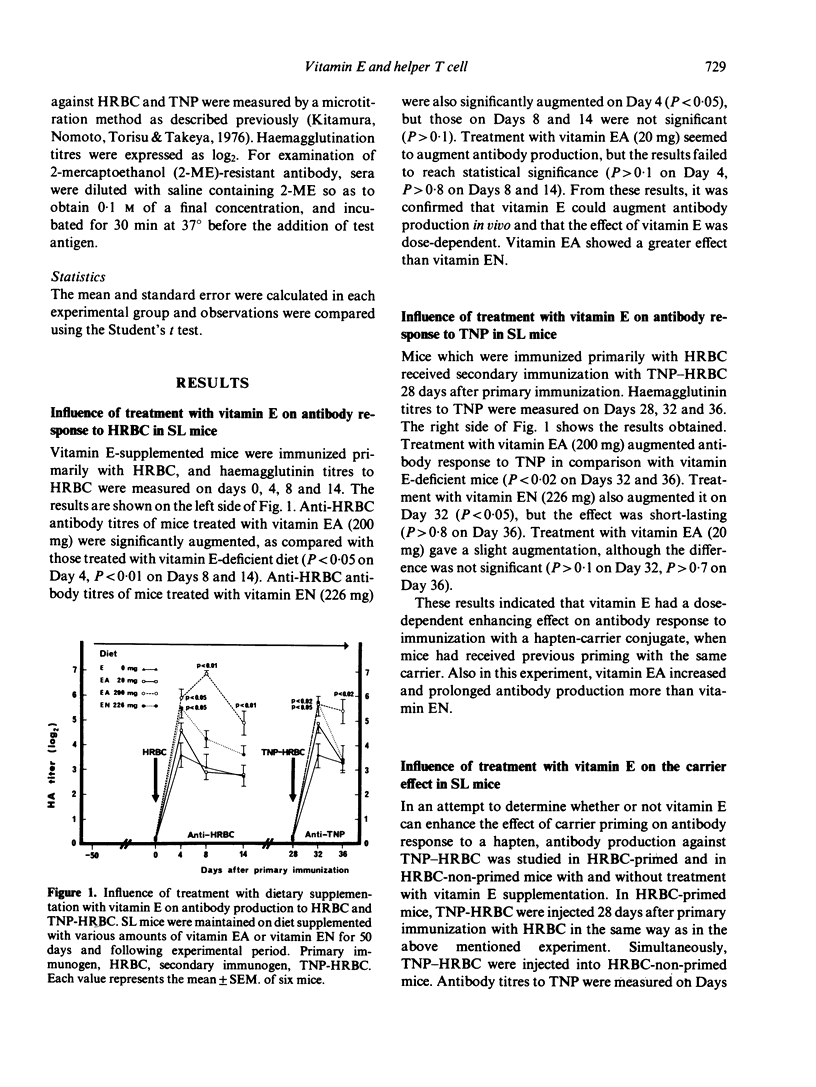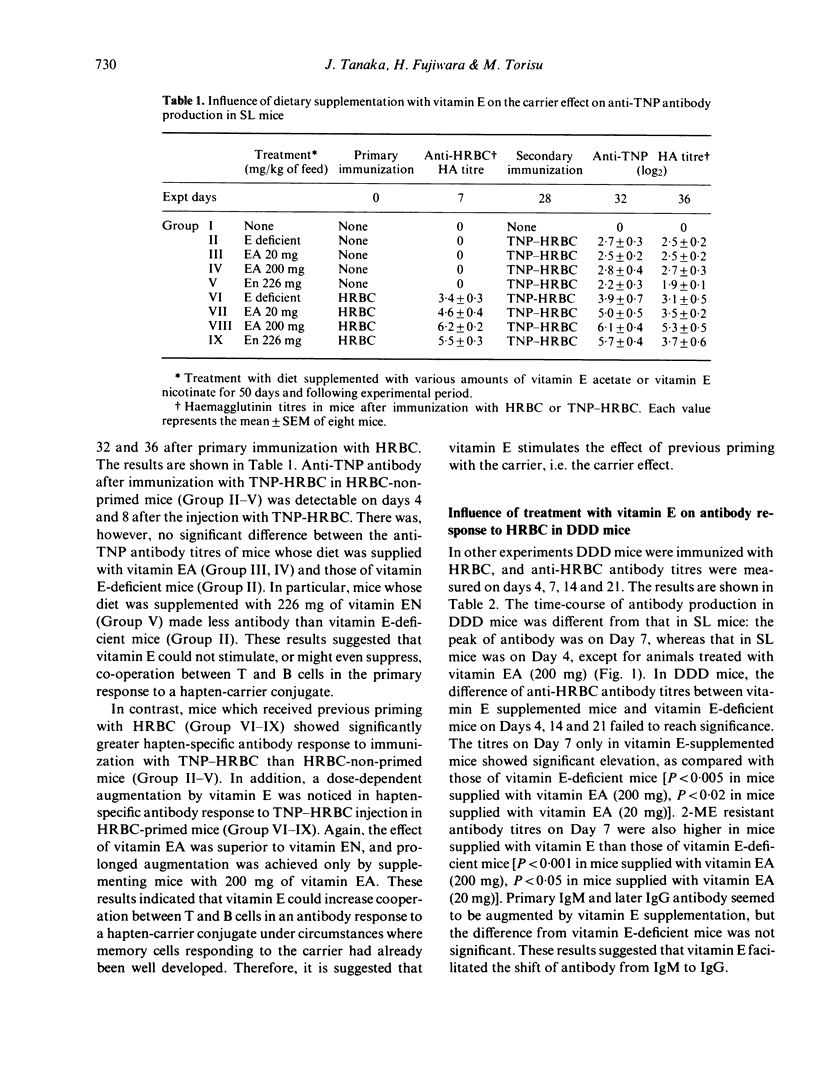Abstract
The effects of vitamin E on the humoral immune response to hamster erythrocytes (HRBC) and 2,4,6-trinitrophenyl (TNP) were studied in mice. Inbred SL mice were fed on a diet supplemented with 0, 20 or 200 mg of vitamin E per kg of food throughout the course of experiments. These mice were immunized primarily with HRBC 50 days after the beginning of treatment with vitamin E supplementation. Secondary immunization with TNP—HRBC, a hapten-carrier conjugate, was given 28 days after primary immunization with HRBC. Anti-HRBC and anti-TNP haemagglutinin titres were increased by supplementing mice with vitamin E. Moreover, the effect of previous priming of mice with HRBC on the hapten-specific antibody response to immunization with TNP-HRBC was also enhanced by vitamin E supplementation. These effects of vitamin E were dose-dependent, and vitamin E as tocopheryl acetate exerted more effect than vitamin E as tocopheryl nicotinate. In experiments with the mouse inbred strain DDD, vitamin E seemed to facilitate the shift of antibody production from IgM to IgG. Initial IgM response and late IgG response were not augmented by treating mice with vitamin E supplementation. These findings suggested that vitamin E stimulated the helper activity of T lymphocytes. This was confirmed using an adoptive transfer system involving stimulation of hapten-primed cells by a hapten-carrier conjugate in the presence of carrier-primed helper cells.
Full text
PDF







Selected References
These references are in PubMed. This may not be the complete list of references from this article.
- Britton S., Möller G. Regulation of antibody synthesis against Escherichia coli endotoxin. I. Suppressive effect of endogenously produced and passively transferred antibodies. J Immunol. 1968 Jun;100(6):1326–1334. [PubMed] [Google Scholar]
- Doria G., Agarossi G., Boraschi D., Antonietta M. Effect of carrier priming on antibody avidity in the in vivo and in vitro immune response. Immunology. 1977 Apr;32(4):539–548. [PMC free article] [PubMed] [Google Scholar]
- Erb P., Feldmann M. The role of macrophages in the generation of T-helper cells. II. The genetic control of the macrophage-T-cell interaction for helper cell induction with soluble antigens. J Exp Med. 1975 Aug 1;142(2):460–472. doi: 10.1084/jem.142.2.460. [DOI] [PMC free article] [PubMed] [Google Scholar]
- Gallo-Torres H. E., Miller O. N., Hamilton J. G., Tratnyek C. Distribution and metabolism of two orally administered esters of tocopherol. Lipids. 1971;6(5):318–325. [PubMed] [Google Scholar]
- Heinzerling R. H., Nockels C. F., Quarles C. L., Tengerdy R. P. Protection of chicks against E. coli infection by dietary supplementation with vitamin E. Proc Soc Exp Biol Med. 1974 May;146(1):279–283. doi: 10.3181/00379727-146-38087. [DOI] [PubMed] [Google Scholar]
- Hurme M., Kontiainen S., Seppälä I. J., Mäkelä O. Affinity and Ig classes of anti-hapten antibodies in carrier-preimmunized rats. Eur J Immunol. 1973 Apr;3(4):191–195. doi: 10.1002/eji.1830030403. [DOI] [PubMed] [Google Scholar]
- Kai S., Tanaka J., Nomoto K., Torisu M. Studies on the immunopotentiating effects of a streptococcal preparation, OK-432. I. Enhancement of T cell-mediated immune responses of mice. Clin Exp Immunol. 1979 Jul;37(1):98–105. [PMC free article] [PubMed] [Google Scholar]
- Kettman J., Dutton R. W. Radioresistance of the enhancing effect of cells from carrier-immunized mice in an in vitro primary immune response. Proc Natl Acad Sci U S A. 1971 Apr;68(4):699–703. doi: 10.1073/pnas.68.4.699. [DOI] [PMC free article] [PubMed] [Google Scholar]
- Kitamura Y., Nomoto K., Torisu M., Takeya K. Effects of BCG (Bacillus Calmette-Guérin) vaccines on immune responses in mice. I. Possible effect of BCG on helper T cells. Jpn J Microbiol. 1976 Aug;20(4):303–308. doi: 10.1111/j.1348-0421.1976.tb00992.x. [DOI] [PubMed] [Google Scholar]
- McCay P. B., Poyer J. L., Pfeifer P. M., May H. E., Gilliam J. M. A function for -tocopherol: stabilization of the microsomal membrane from radical attack during TPNH-dependent oxidations. Lipids. 1971;6(5):297–306. [PubMed] [Google Scholar]
- Miller J. F., Dukor P., Grant G., Sinclair N. R., Sacquet E. The immunological responsiveness of germ-free mice thymectomized at birth. I. Antibody production and skin homograft rejection. Clin Exp Immunol. 1967 Sep;2(5):531–542. [PMC free article] [PubMed] [Google Scholar]
- Mitchison N. A. The carrier effect in the secondary response to hapten-protein conjugates. I. Measurement of the effect with transferred cells and objections to the local environment hypothesis. Eur J Immunol. 1971 Jan;1(1):10–17. doi: 10.1002/eji.1830010103. [DOI] [PubMed] [Google Scholar]
- Nomoto K., Mashiba H., Takeya K. Immune response against hamster erythrocytes in the low-responder mouse strains. I. Strain difference in the antibody response to primary antigenic stimulation and its disappearance after pre-sensitization with the antigen in Freund's complete adjuvant. Jpn J Microbiol. 1972 Jan;16(1):43–51. doi: 10.1111/j.1348-0421.1972.tb00626.x. [DOI] [PubMed] [Google Scholar]
- Rajewsky K., Schirrmacher V., Nase S., Jerne N. K. The requirement of more than one antigenic determinant for immunogenicity. J Exp Med. 1969 Jun 1;129(6):1131–1143. doi: 10.1084/jem.129.6.1131. [DOI] [PMC free article] [PubMed] [Google Scholar]
- Rittenberg M. B., Amkraut A. A. Immunogenicity of trinitrophenyl-hemocyanin: production of primary and secondary anti-hapten precipitins. J Immunol. 1966 Sep;97(3):421–430. [PubMed] [Google Scholar]
- Rittenberg M. B., Pratt K. L. Antitrinitrophenyl (TNP) plaque assay. Primary response of Balb/c mice to soluble and particulate immunogen. Proc Soc Exp Biol Med. 1969 Nov;132(2):575–581. doi: 10.3181/00379727-132-34264. [DOI] [PubMed] [Google Scholar]
- Steiner M., Anastasi J. Vitamin E. An inhibitor of the platelet release reaction. J Clin Invest. 1976 Mar;57(3):732–737. doi: 10.1172/JCI108331. [DOI] [PMC free article] [PubMed] [Google Scholar]
- Takatsu K., Hamaoka T., Kitagawa M. Antibody production in mice. VI. Effect of anti-carrier antibody on cellular co-operation in the primary anti-hapten antibody response. Immunology. 1974 Feb;26(2):233–246. [PMC free article] [PubMed] [Google Scholar]
- Tappel A. L. Vitamin E and free radical peroxidation of lipids. Ann N Y Acad Sci. 1972 Dec 18;203:12–28. doi: 10.1111/j.1749-6632.1972.tb27851.x. [DOI] [PubMed] [Google Scholar]
- Tengerdy R. P., Heinzerling R. H., Nockels C. F. Effect of vitamin E on the immune response of hypoxic and normal chickens. Infect Immun. 1972 Jun;5(6):987–989. doi: 10.1128/iai.5.6.987-989.1972. [DOI] [PMC free article] [PubMed] [Google Scholar]
- Tengerdy R. P., Henzerling R. H., Brown G. L., Mathias M. M. Enhancement of the humoral immune response by vitamin E. Int Arch Allergy Appl Immunol. 1973;44(2):221–232. doi: 10.1159/000230931. [DOI] [PubMed] [Google Scholar]


